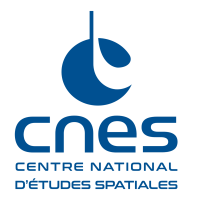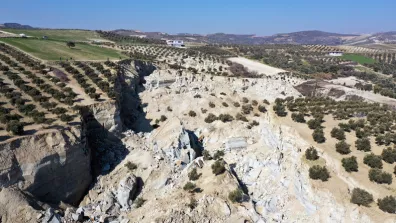
Major landslide in olive groves in Hatay due to fault rupture in the earthquake in Turkey. Aerial view of crushed clay blocks and rocks. Copyrights: Mahmut Sommez - Getty Images.
Two large earthquakes of magnitude greater than 7 have struck Turkey and Syria causing significant destruction. The international scientific community is studying the geophysical processes of this rare event.
On February 6, 2023, two earthquakes of magnitude (MW) 7.8 and 7.5 struck southern Turkey and northern Syria, causing devastating effects on the ground by opening large ruptures and locally displacing the earth's crust by 5 to 10 m.
The longer of the two ruptures extends nearly 300 km northeastward from the Mediterranean Sea. The surface rupture was created by the first and most powerful earthquake of magnitude 7.8 that triggered at 4:17 a.m. local time; the second 125 km long surface rupture opened during the second earthquake of magnitude 7.5 about nine hours later.
The International Charter Space and Major Disasters was activated on February 6, 2023. CNES coordinated the programming of French satellites to provide images of the disaster areas as quickly as possible (see online article of February 13, 2023).
In parallel, several actions of the international scientific community are underway, including within the CEOS Working Group Disasters, to study in detail the geophysical processes of the event described as rare (the second earthquake, directly caused by the first with a similar intensity, is called "triggered earthquake").
At the national level, various initiatives are currently being implemented within the framework of the ForM@Ter data and services cluster (dealing with solid Earth and geological hazards) to provide elements of analysis on the deformation of the ground following this major event, in particular using data acquired by satellite.
First preliminary results are presented below.
Displacement map by optical imagery
The current constellation of Earth observation satellites allowed a rapid acquisition of the entired affected area shortly after the main tremors. The Copernicus Sentinel-2 satellite was able to acquire several optical images over the largely cloud-free region. By comparing several optical satellite images before and after the earthquake, horizontal ground displacements can be calculated using image correlation techniques.
The figures below illustrate the co-seismic horizontal displacements obtained from the analysis of Copernicus Sentinel-2 satellite imagery, covering more than 300 km along the faults, at a spatial resolution of 10 m.


Legend: Maps of co-seismic horizontal displacements obtained from analysis of Copernicus Sentinel-2 satellite imagery at 10 m spatial resolution. - Top: North-South; Bottom: West-East. Courtesy: EOST Laboratory - Strasbourg.
These maps contribute significantly to the identification and mapping of surface ruptures and determine displacement along faults. Impressive spatial offsets on the order of 3 m to nearly 10 m are identified with high geographic variability along faults.
Final products were obtained with the GDM-OPT-ETQ service of the Data-Terra Research Infrastructure's ForM@Ter Solid Earth data and services cluster to measure co-seismic displacements between the January 25, 2023 and February 9, 2023 images.
Displacement map using radar imagery
Satellite radar imagery allows scientists to observe and analyze the effects of earthquakes. The Copernicus Sentinel-1 mission carries a radar instrument capable of detecting the ground and "seeing" through clouds, day and night.
The figure below shows the first interferometric processing without atmospheric corrections of the 240 km swath Sentinel-1A IW data: the first post-earthquake image was taken on February 9, 2023 at 15:35 UT in ascending orbit 14, the next one in descending orbit 21 the next morning on February 10, 2023 at 03:35 UT, combined respectively with an image taken 12 days earlier in the same orbital conditions.


Legend: Interferograms without atmospheric corrections of Sentinel-1A IW data from 240 km swath a) ascending orbit 14; b) descending orbit 21. Courtesy Léa Pousse UGA/ISTerre.
On these differential interferograms (deduced relief), each phase turn measures a displacement of 2.8 cm (half wavelength of the Sentinel1 carrier at 5.405 GHz) in the viewing direction of the sensor. Far from the fault, the displacement should be zero, but here the displacements overflow the image and less fringe spacing is only observed, reflecting less deformation. Near the faults, the bangs tighten up, showing a strong displacement, until they disappear in the noise because the displacement exceeds the admissible conditions in interferometry.
The observed deformation area is exceptional, extending well beyond the very large image of 240 km wide and more than 300 km along the track: several Sentinel1 products must be concatenated to arrive at this preliminary result.
The first products were obtained by the GDM-SAR service, in the validation phase, of the ForM@Ter data cluster in close cooperation between CNES and ISTerre/IPGP laboratories and which allows, from data archived on PEPS (Platform for exploitation of Sentinel products at CNES), and a simple interface, to generate series of interferograms and time series to derive fine measurements of displacement speed.
Actions in progress and prospects
- The CIEST2 (Cellule d'expertise Scientifique et Technique) has been activated.
This initiative allows scientists from the French Solid Earth community to provide a first rapid interpretation of geophysical phenomena from specific programming of Pleiades imagery in response to a natural disaster.
In particular, it allows the generation of digital surface models (DSM) from Pleiades stereo/tri-stereo imagery via the DSM-OPT (Digital Surface Models from OPTical stereoscopic very-high resolution imagery) on-demand service.
- The InSAR FLATSIM service operated by CNES, in collaboration with the scientific community, produces time series of displacements over large geographical areas, ensuring the spatio-temporal monitoring of critical regions.
Turkey has been the subject of a massive FLATSIM processing over the period 2014 - 2021. An incremental treatment of this area is planned (2020 - 2023) in order to have a history of ground displacement. In addition, a project submitted in 2022 on Levant will complete the southern parts of the affected areas.
In the medium term, a reflection is underway within the ForM@ter data center to set up a "risk service" to better coordinate the various scientific initiatives taken during events of this type.
Contacts
Claude Boniface, CNES Project Manager – ForM@ter Data and Services Center
E-mail : claude.boniface at cnes.fr
Philippe Durand, specialist in SAR images at CNES, in support of FLATSIM and GDM-SAR projects
Email : philippe.durand at cnes.fr


